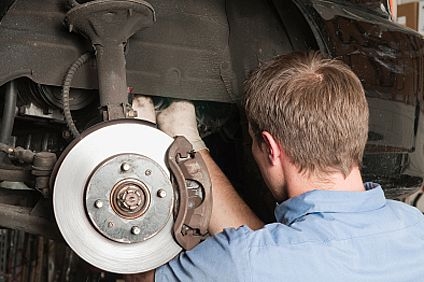
Automotive hydraulic braking systems can sometimes squeal and squeak, which can indicate excessive wear and the need for repair. Disc brakes are designed to squeal when they have a low amount of material on the pads, and drum brakes can make squeaking sounds when they are not operating properly. The average backyard mechanic can fix squealing brakes in about 30 minutes.
Spray a liberal amount of disc brake dressing into the opening in the center of the caliper, getting the spray onto the rear of the disc brake pads. Do not spray the dressing onto the rotor or the sides of the pad, only through the designed opening. The dressing helps the caliper piston retrieve the pad, and prevent it from touching the rotor when not in use.
Replace the brake pads by removing the caliper from the rotor, then pulling the pads out and positioning new units onto the caliper pistons. Brake pads are designed to squeal after so much of their material is worn away, to alert the driver that the pads need replacement. A small tab of metal scrapes against the rotor, and if left unfixed, the rotor can sustain heavy damage.
Replace the drum brake shoes by removing the drum from the assembly and releasing the springs that hold the shoe in place. Shoe material can scrape and squeal when it falls below the safe thickness, but shoes do not have a squealer tab like disc brakes. Sometimes the shoe material can collect in the bottom of the drum and cause misalignment, which can make a horrible sound when the shoe makes sustained contact with the drum or other brake parts. Check for debris in the drum before replacing the shoes, but typically the shoes are damaged from the debris and must be replaced anyway.
Wash the brakes with a high-pressure hose, when they are cold and have not been used in several hours. Debris and dust can cause squealing when stuck in critical brake components, such as calipers and shoes. Dust often goes unnoticed and can cause a number of problems, including heat-related issues such as warped rotors.
Check the master cylinder for the proper fluid level and color by uncapping it and visually inspecting the fluid. The master cylinder is usually located under the hood on the driver's side firewall, but locations vary. The fluid should be golden, and be filled to the line on the side of the translucent reservoir. Black or missing fluid could indicate air or heat problems, which can cause "weak" calipers to not retract the pads fully, leading to squealing sounds.